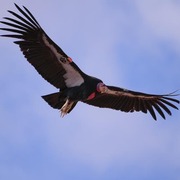California Condor
Gymnogyps
californianus
Falconiformes
The hawks, eagles, falcons, and allies make up a group known as the diurnal raptors, because they are active during the day. Members of this group typically use their acute vision to catch live vertebrate prey with their strong feet and toes. They vary from medium-sized to large birds and most have an upright posture and strong, short, hooked bills. The New World vultures (not closely related to the Old World vultures) were once classified with the herons and allies, but they have provisionally been grouped with the diurnal raptors on the basis of recent genetic studies. Members of the order Falconiformes in Washington fall into three families:
Cathartidae
The family name, Cathartidae, comes from the Greek word for cleanser, and that is exactly the function these scavengers serve—cleaning dead animals from the land. They are often seen soaring overhead, looking for dead animals to eat. Their bald heads help them stay clean when eating carrion. These sociable birds often gather in communal roosts at night and will gather to feed around large carcasses. Their nesting sites are usually far removed from the disturbance of humans. They generally lay two eggs, which both parents help incubate. They regurgitate ingested food for their young.
General Description
Large numbers of condors once came to the Columbia River to feast on salmon carcasses in fall spawning season. The last record is from 1897.



